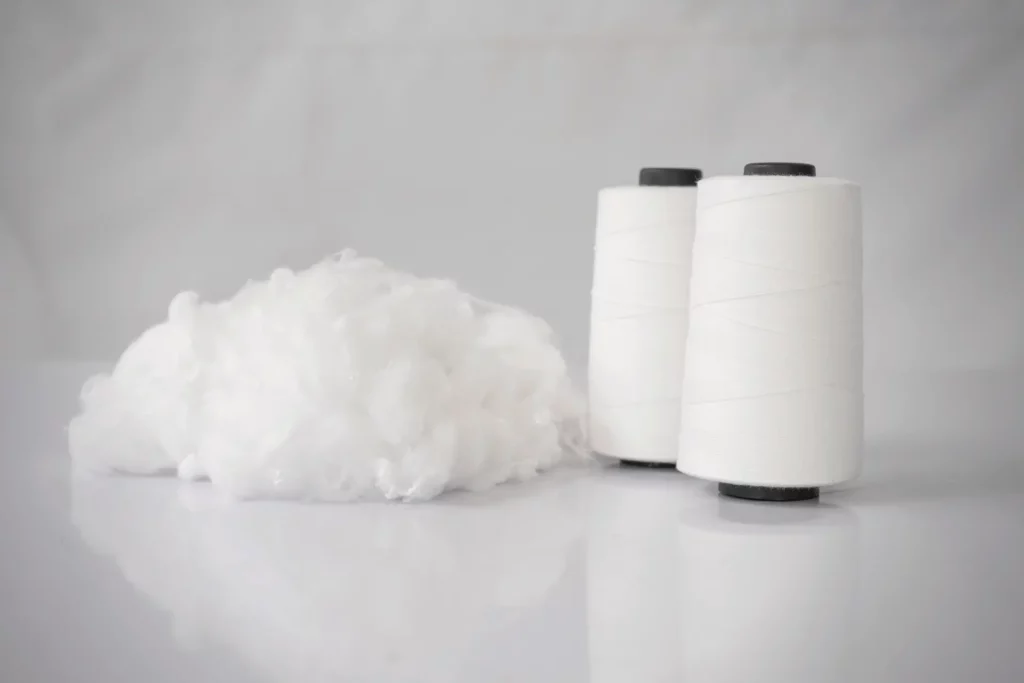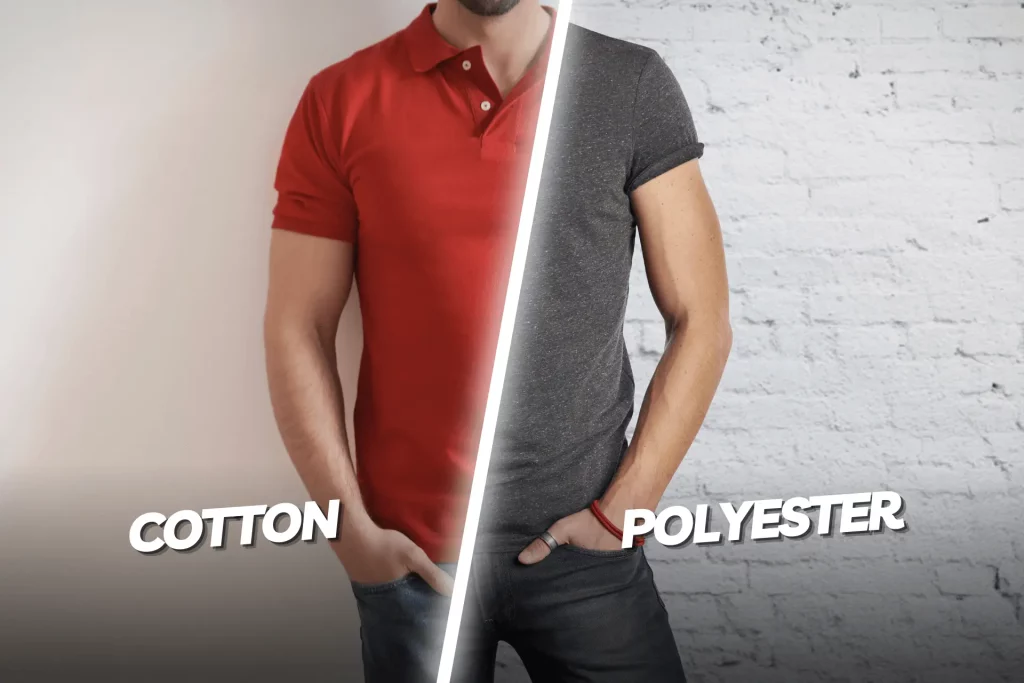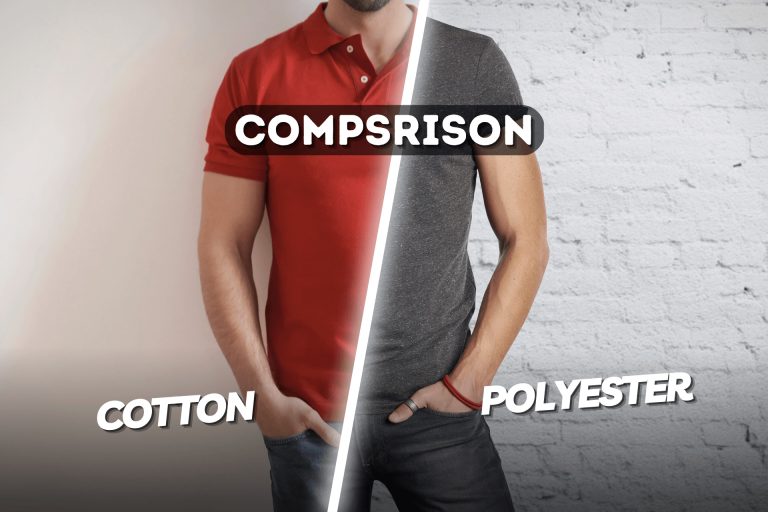Cotton and polyester are two of the materials utilized the most frequently on the market when it comes to selecting fabrics. Not only are they available at a range of prices, but each also comes with its own set of advantages and disadvantages, which should be weighed carefully before making any choices.
This comparison of cotton and polyester will undoubtedly assist you in making the most educated choice possible, regardless of whether you prioritize more excellent breathability or a longer lifetime in the articles of clothing you purchase.
Continue reading as we take an in-depth look at these textiles, discussing everything from their cost-effectiveness and degree of comfort to how well they withstand wear and tear over time.
Table of Contents
What is Cotton?

The cotton plant is the source of cotton, a type of textile known as a staple fiber. The fibers appear like a flat, twisted ribbon across their whole. Because the cotton plant needs warm weather for 6-7 months out of the year, it thrives best in subtropical nations with warm and humid temperatures.
Because cotton fiber typically contains around 94% cellulose, cotton is the purest type of cellulose that can be found in nature. Cotton fiber may range in color from virtually pure white to filthy grey, green, and dark brown.
The color of cotton fiber is commonly creamy white or yellowish, but it can also be other colors. Cotton that is already naturally colored and does not need to be dyed is highly prized. This is because when it is sown, it takes very little upkeep or water, does not require fertilizers, and is far more resistant to pests and illnesses.
Like any other natural or artificial material, cotton has positive and negative aspects. Because of this, it is of the utmost importance that we offer accurate facts and numbers about cotton, whose name has been synonymous with the concept of a fabric unsuitable for strenuous outdoor activities such as hiking.
The expression “cotton kills” has recently gained a great deal of popularity; however, are you familiar with the reasoning behind why people say this? We will endeavor to respond to the question so that the next time you hear that statement, you will be able to determine whether it is true.
Pros of Cotton:
- Cotton has a high strength-to-weight ratio. Moreover, it becomes more robust or tenacious as its moisture content rises. In most cases, wet cotton will be 25% stronger than dry. A cotton cloth that has been soaked in water is far more durable than one that has been left dry (which enables a smoother manufacturing process). As a result, cotton clothing may be washed and worn repeatedly without losing shape or color. Cotton shirts and pants may also be ironed safely because the fabric is resistant to mild heat.
- Cotton is a natural material that is both soft and breathable. All finished goods fabricated from this material share the same qualities. As a result, cotton is commonly used for intimate apparel such as underwear, socks, and other items worn next to the skin.
- Cotton is a natural heat conductor that keeps you cool in the summer and warm in the winter. While cotton is ideal for trekking in the desert and other hot climates, it poses a risk while hiking at night because of the low temperatures.
- Cotton can quickly soak up and release significant quantities of moisture (water, perspiration, etc.) without making the wearer feel damp or sticky. A cotton textile or garment may absorb up to 27 times its weight in water. This vital quality is what makes wearing cotton so refreshing and relaxing. As a result of this and the fact that cotton is naturally white, the fiber may readily absorb any color applied to it.
- Cotton’s adaptability makes it a popular material for many goods, from clothing staples like trousers and tees to more unusual items like tents, roller blinds, wall coverings, and tarps.
- Strong resistance to heat and flame; nonetheless, exposure to light will produce yellowing with time. The good news is that cotton garments are extremely bleach-resistant.
- Because it does not aggravate sensitive skin and does not trigger allergic reactions, it is the perfect material for allergy sufferers.
Cons of Cotton:
Cotton fabric can be damaging to the environment. Large-scale cotton production requires a lot of water, energy, and chemicals for growing, harvesting, processing, and dyeing. Furthermore, the pesticides used in cotton farming have toxic effects on plants, animals, and humans alike, leading to water and soil contamination that can persist for years.
Additionally, bleaching cotton with chlorine leads to the release of hazardous toxins into our environment. This contributes to global warming and other environmental problems such as air pollution.
Therefore, it’s essential to consider how your clothing is produced before making any purchases. Think twice about investing in items made from cotton if you’re looking for an eco-friendly option!
Another disadvantage of cotton is that it can be pretty expensive. This is because of the knowledge, labor, and resources needed to produce high-quality cotton fabrics.
Additionally, due to its delicate nature, there’s a limit to how much you can do with it – specific finishes or treatments may not be suitable for this type of fabric. Finally, cotton tends to wrinkle easily during wearing or washing, so extra care must be taken for your garments made from this material.
Cotton is a lightweight option during the summer season, while Merino wool is an alternative to cotton for its temperature regulating properties. Examine the debate over fabric properties.
What is Polyester?

Polyester is the most widely used fiber in the world today, and its demand has been expanding at the quickest rate compared to other threads since 1980, accounting for around 73% of the overall rise in fiber demand.
It is utilized to produce athletic apparel, textile industries, belts, tarps, drapes, draperies, upholsteries, carpets, tire cords, ropes, and nets, among other things.
Pros of Polyester:
- Polyester has 0.4% moisture regain. Polyester is stain-resistant and water-repellent. Polyester is hydrophobic; however, a finish or chemical change can change its surface. Water-repellent and fast-drying fabric results.
- Polyester fiber is tough and wear-resistant.
- Heat- and chemical-resistant. These are ideal for UV protection.
- Easily textured and changed, including elasticity and pilling. COOLMAX is modified polyester. Lightweight hydrophilic polyester is channeled. Each COOLMAX fiber contains four wicking channels to distribute and evaporate moisture swiftly and is extremely air permeable to speed drying and keep the user cool and dry. Polyester may be recycled from plastic bottles. Many sportswear manufacturers employ recycled polyester.
- Polyester retains creases longer and wrinkles less. This makes it great for daily wear.
- Washable and non-shrinking. Polyester is considered the lowest-maintenance fabric.
- Blendable and cheap.
- Stable and unaffected by moisture. Hollow polyester fibers insulate and absorb moisture.
- Good insect and microbial resistance.
Cons of Polyester:
- Non-breathable and unpleasant on the skin, especially in hot weather (except for some modified polyesters such as COOLMAX). Low moisture absorption, vapor transfer, and heat conductivity are the significant causes.
- Polyester clothing is difficult to clean because water and chemicals cannot penetrate its chemical resistance and limited absorbency.
- Polyester clothing creates static electricity due to hydrophobicity.
- Polyester is hefty. Lightweight or thin materials are used to overcome this. For trekking, heavier polyester gear would be a disadvantage.
- Polyester absorbs scents, making it unsuitable for multi-day excursions. Any 30-minute high-intensity activity stinks.
For optimal breathability, merino wool is a superior choice when compared to polyester fabric. Take a look at the benefits and drawbacks of both stuffs.
What’s Similar between Cotton and Polyester:
Cotton and polyester are both widely used fabrics in today’s fashion industry. Both materials have unique characteristics but also share many similarities. To start, cotton and polyester are easy to care for–they require minimal maintenance and can usually be machine washed. They’re both non-allergenic and can be used for various apparel items.
Another common trait between cotton and polyester is that both materials are highly durable, so they are great for more active wear like sports clothing or everyday apparel. Lastly, they are both cost-effective fabrics, which makes them ideal for those on a budget.
Cotton and polyester may have different characteristics, but they also have a lot in common, making them both excellent materials for fashion. With various uses and a range of similarities, it’s no wonder these fabrics are some of the most popular in the industry.
A Comparison of Cotton vs. Polyester:

- Cotton is made of natural fibers, while polyester is made from synthetic ingredients.
- Because of the different chemical components that make it up, polyester is a more durable material than cotton and has a larger capacity to stretch.
- Because polyester is hydrophobic, textiles manufactured with polyester do not absorb sweat; this is because polyester itself does not absorb water. On the other hand, cotton can absorb moisture.
- Cotton is not only more hypoallergenic than polyester, but it also breathes better than polyester does. Those with sensitive skin react better to 100 percent cotton than polyester. Cotton fabric may be found that has undergone very minimal chemical processing since organic products are becoming an increasingly popular choice.
- Polyester is less likely to fade and better resistant to wrinkles and stains than cotton.
- Polyester tends to stick to the skin, in contrast to cotton, which has a pleasant sensation when worn next to the skin.
- Polyester takes less time to dry than cotton does.
- Cotton textiles, unless treated in advance to prevent this shrinkage, shrink after the first time they are washed. Polyester does not shrink and is superior to cotton in maintaining its form.
- Because polyester clings to doors more than cotton, it must be cleaned more regularly to maintain its appearance. Body doors might be challenging to open even after they have been cleaned.
Environmental Impact:
Cotton is sustainable if cultivated properly—pesticide-free cotton. Polyester takes hundreds of years to decompose, whereas cotton biodegrades. Conventional cotton cultivation utilizes the most insecticides worldwide. Chemicals enter groundwater and streams when it rains, or the plant decomposes. Cotton requires a lot of acreage, water, and mechanized harvesting equipment. Cotton requires plenty of land, water, and energy.
Polyester hurts the environment throughout its manufacture and accumulates in the world’s ecosystems and seas with no way to remove it. Plant-based polyester fibers and pets may help address this problem. These alternatives to petroleum-based polyester may need to achieve more market share to reduce polyester pollution.
Breathability:
When it comes to fabric and breathability, cotton is a clear winner. Cotton has breathable natural fibers that allow air to pass through them quickly. This means you won’t feel as stuffy when wearing cotton clothing as with polyester garments.
Polyester doesn’t have the same wicking ability as cotton because its synthetic fibers don’t naturally absorb moisture or sweat like cotton can, so while it keeps you warm in colder temperatures, it can make you feel hot and sticky when the temperature rises. If breathability is important to you, stick with cotton over polyester for the most comfortable experience.
Durability:
Cotton and polyester both have their pros and cons when it comes to durability. Cotton is generally considered more durable since it can last for years with proper care. In contrast, polyester is less solid and long-lasting. It’s prone to pilling, fading, and stretching out over time.
However, if you’re looking for something easy to maintain that won’t cost you a fortune, polyester is your better choice. While cotton may be the sturdier material in wearability, it can also require frequent washing and upkeep due to its tendency to shrink or fade quickly.
Frequently Asked Questions:
Are cotton clothes good?
Cotton clothes are excellent for everyday wear. The material is lightweight, breathable, and comfortable – perfect for lounging around the house or going about daily activities. Cotton is also highly absorbent, meaning it’ll keep you cool in hot weather and warm in cold weather. Plus, it’s reasonably durable and easy to clean! Another plus side of cotton clothes is that they’re usually quite affordable compared to other fabrics.
Is polyester comfortable?
The fact that polyester clothing is constructed out of synthetic fibers is one aspect that should be considered while purchasing. Polyester is not produced naturally; thus, it has the potential to irritate skin that is already sensitive. On the other hand, most individuals agree that a polyester is an attractive option for sportswear since it is soft and breathable.
Is polyester soft?
The texture of polyester can be described as “silky,” smooth, and velvety. Depending on the grade of the polyester used to make the clothing, the surface of the polyester might range from soft to grainy.
Bottom Line:
You may have to decide between cotton and polyester when looking for blank tees. There is no definitive answer to the question of what constitutes the “best” fabric for clothes. It all comes down to the function of the shirt or the method of decorating it. Every type of clothing has its advantages and disadvantages, so it’s up to you to determine which ones are more significant.
Keep track of what works and what doesn’t by noting the positive and negative aspects of each garment and brand you try. Knowing the fundamental distinctions between cotton and polyester will save you time and effort as you navigate the vast landscape of blank apparel.

